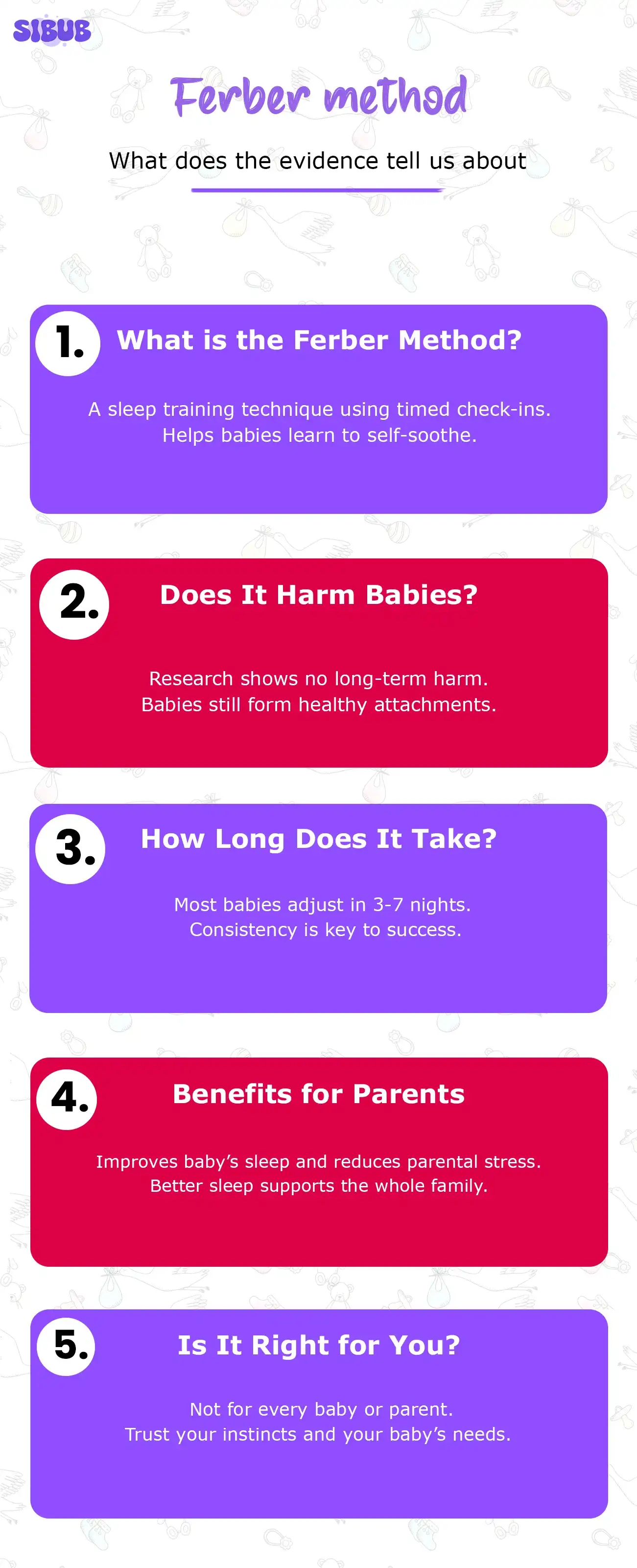Ferberize, the word alone, triggers heated debates across parenting circles. Some swear by it. Others flinch at the thought. But what exactly happens when you choose to ferberize your baby? And more importantly, what does the evidence say about this often misunderstood sleep training method?
Parents are exhausted. Sleep is broken. And when nights become an endless loop of rocking, feeding, and bouncing, many start Googling, reading books, asking friends… looking for a way out of the cycle. Enter cry it out sleep training, especially the version known as the Ferber sleep method.
But wait. Before you picture a baby sobbing for hours while helplessly ignored, pause. The truth is messier, more nuanced. And the Ferberizing technique isn’t what many critics assume it to be.
Let’s pull this apart piece by piece, short paragraphs, clear facts, and yes, all backed by science.
What Is the Ferber Method of Sleep Training?
Named after Dr. Richard Ferber, the Ferber method of sleep training is a form of graduated extinction. It falls under the broader family of extinction sleep training techniques.
To understand it the easy way: parents put their baby down drowsy but awake, then leave the room. If the baby cries, the parent waits a set amount of time before going back in for a quick comfort check. Over time, those intervals of going back in increase. The goal of this practice is to teach the baby to self-soothe and sleep independently.
Sounds cold? It’s not. You don’t disappear forever. You return. Briefly. Comfort. Leave again. It’s structured, not abandonment.
Let’s be clear: Ferberizing doesn’t mean “ignore your baby until they pass out.” It means stepping back to give your child space to learn a key developmental skill, falling asleep on their own.

Visit: 12 Tips to Help Your Child Become Friends with Kids Easily and Confidently
The Extinction Method vs. Ferberizing: Same Thing?
Not quite.
The extinction method in its purest form, often dubbed “cry it out,” involves no return checks. You put the baby down and let them cry until they fall asleep. That’s it. No time intervals. No comfort visits.
By contrast, Ferberizing uses graduated extinction, a middle path. There’s structure. There’s presence. There’s a system. You check in at gradually increasing intervals over several nights.
The difference is huge. One is full detachment; the other is strategic detachment with safety nets.
Does the Ferber Method Work?
In short? Yes. Overwhelmingly, the data says ferberizing works, both short-term and long-term.
A 2006 study published in Pediatrics followed infants who underwent extinction sleep training (both gradual and full) and found significant sleep improvements within a few nights. Cry duration dropped. Sleep length increased. Parent sleep improved too.
Another long-term study tracked families five years after cry it out sleep training. The results? No difference in emotional security, attachment, or behavior between sleep-trained kids and non-sleep-trained ones.
Translation: it works. It’s safe. And no, you’re not damaging your child.
Ferber Method at 3 Months – Too Early?
This one’s tricky.
Technically, Dr. Ferber recommends starting his method around 4 to 6 months, once babies can sleep longer stretches without feeding.
But every baby is different. Some 3-month-olds might handle gentle versions of ferberizing. Others won’t.
The key? Wait until your baby can self-soothe and doesn’t need frequent nighttime feedings. That’s usually after the fourth-month sleep regression. Trying the Ferber method at 3 months? Maybe ease in. But talk to your pediatrician first.
Discover: 9 Month Old Food Ideas – One-Day Meal Plan for 8–12 Month Babies
The Science Behind Sleep Training
Sleep training is emotional terrain. Let’s ground it in real data.
- Cortisol studies show that while babies do produce stress hormones when crying, these levels drop quickly once they fall asleep, and return to baseline over nights. No cumulative trauma.
- MRI research reveals no evidence of neurological harm from extinction methods. Brain development remains normal, regardless of how babies fall asleep.
Critics often equate crying with neglect. But if crying equals harm, then every teething phase, car seat protest, or diaper change would scar a child. It doesn’t. Controlled crying within a loving, responsive environment isn’t neglect. It’s challenge + support.

Ferber Method Pros and Cons
Every method has a trade-off. Here’s a brutally honest rundown:
Pros:
- Fast results: Many parents report improved sleep within 3 to 7 days.
- Promotes self-soothing: Kids learn to fall asleep without rocking, feeding, or bouncing.
- Better parent sleep: Let’s be real, well-rested parents are better parents.
- Scientifically validated: It works across cultures, ages, and even in twins.
Cons:
- Tears happen: You’ll hear crying. Possibly for a few nights. It’s hard.
- Consistency is non-negotiable: Wavering back and forth confuses the baby and backfires.
- Not for every temperament: Some sensitive babies may take longer or need tweaks.
Ultimately, the Ferber method pros and cons come down to your child, your family’s sleep goals, and your tolerance for short-term discomfort.
Explore: How to Play Pick Up Sticks—Rules, Tips & Fun Variations
Common Myths About Ferberizing Technique
Let’s cut through the noise.
“You’re teaching your baby that no one comes when they cry.”
False. The Ferberizing technique includes parental check-ins. You’re not abandoning your child, you’re giving them a learning moment. Big difference.
“It causes attachment issues.”
Nope. Decades of research shows securely attached children can be sleep trained. Responsiveness during the day matters far more than a few nights of structured bedtime crying.
“Sleep training means zero night feeds.”
Wrong. You can sleep train and still feed. You can even set “dream feeds” and train around them. This is about falling asleep, not starving your baby.

How to Ferberize (Without Losing Your Mind)
It doesn’t have to be a horror movie. Here’s a basic flow:
- Bedtime routine: Keep it simple. Bath, bottle/nurse, books, bed.
- Put baby down awake: Drowsy, yes. Asleep? No.
- Leave the room.
- Set a timer: Start with 3 minutes. Then go in, pat or speak softly, no picking up.
- Leave again. Next check-in after 5 minutes. Then 10. Keep increasing each night.
- Repeat. If the baby falls asleep, you win. If not, keep going.
By night three or four, most babies adjust. Some quicker. Some longer. But you’ll see progress. You will.
Parents’ Guilt: Let’s Talk About It
Some feel crushing guilt during cry it out sleep training. The sobs. The clock-watching. The second-guessing.
Here’s what you need to know: Loving parents sleep train. Neglectful parents don’t worry about their baby’s emotional health. If you’re stressed about it? You’re already a great parent.
Sleep training isn’t about “toughening up” your baby. It’s about trusting them to learn and supporting them along the way.
Can You Ferberize an Older Baby or Toddler?
Yes, but expect more resistance.
Older babies have habits. Toddlers have opinions. Sleep training at 10 months or 18 months may involve louder protests. But it still works. The method doesn’t change; just your patience level does.
Consistency becomes even more important here. Backtracking confuses toddlers and creates power struggles. Stick with it, and the gains come.
What Pediatricians and Researchers Say
The Ferber sleep method isn’t fringe advice; it’s standard sleep training fare recommended by many pediatricians.
Dr. Jodi Mindell, a clinical psychologist and sleep researcher, notes that babies who learn to self-soothe early tend to sleep better for years. And Dr. Ferber himself has stated that most families only need 3–5 nights for noticeable improvements.
If done correctly, ferberizing is effective, gentle (yes, gentle), and backed by both data and decades of clinical use.
So, Should You Ferberize?
Only you can decide. But if you’re ready for structured change, if your baby is old enough, and if your mental health is being ground down by night wakings, this might be your sign.
Remember: you can love your baby fiercely and still teach them to sleep.
Learn More: How to Play Charades: Rules for Kids
Therefore,
The Ferber method of sleep training isn’t magic. But it works. It’s structured, evidence-based, and often misunderstood. Done right, ferberizing can transform nights for both babies and parents.
So if you’re staring down another sleepless night, know this: You’re not alone. Thousands of parents have been exactly where you are and come out the other side with full nights of sleep, happier babies, and clearer minds.
Let go of the guilt. Hold on to the science. And trust that teaching your baby to sleep doesn’t make you cold, it makes you confident.
